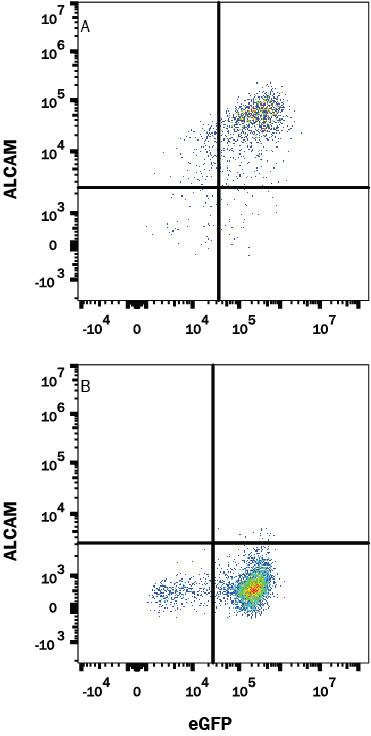Human ALCAM/CD166 Antibody
R&D Systems, part of Bio-Techne | Catalog # MAB6563


Key Product Details
Species Reactivity
Applications
Label
Antibody Source
Product Specifications
Immunogen
Trp28-Ala526
Accession # Q13740
Specificity
Clonality
Host
Isotype
Scientific Data Images for Human ALCAM/CD166 Antibody
Detection of Human ALCAM/CD166 by Western Blot.
Western blot shows lysates of A549 human lung carcinoma cell line and U2OS human osteosarcoma cell line. PVDF membrane was probed with 2 µg/mL of Rabbit Anti-Human ALCAM/CD166 Monoclonal Antibody (Catalog # MAB6563) followed by HRP-conjugated Anti-Rabbit IgG Secondary Antibody (HAF008). A specific band was detected for ALCAM/CD166 at approximately 105 kDa (as indicated). This experiment was conducted under reducing conditions and using Immunoblot Buffer Group 1.Detection of ALCAM in HEK293 Human Cell Line Transfected with Human ALCAM and eGFP by Flow Cytometry.
HEK293 human embryonic kidney cell line transfected with (A) human ALCAM or (B) irrelevant protein and eGFP was stained with Rabbit Anti-Human ALCAM Monoclonal Antibody (Catalog # MAB6563) followed by APC-conjugated Anti-Rabbit IgG Secondary Antibody (F0111). Quadrant markers were set based on control antibody staining (MAB1050). Staining was performed using our Staining Membrane-associated Proteins protocol.ALCAM/CD166 in A431 Human Cell Line.
ALCAM/CD166 was detected in immersion fixed A431 human epithelial carcinoma cell line using Rabbit Anti-Human ALCAM/CD166 Monoclonal Antibody (Catalog # MAB6563) at 3 µg/mL for 3 hours at room temperature. Cells were stained using the NorthernLights™ 557-conjugated Anti-Rabbit IgG Secondary Antibody (red; NL004) and counterstained with DAPI (blue). Specific staining was localized to cell surface.Staining was performed using our Fluorescent ICC Staining of Cells on Coverslips Protocol.Applications for Human ALCAM/CD166 Antibody
CyTOF-ready
Flow Cytometry
Sample: HEK293 Human Cell Line Transfected with Human ALCAM and eGFP
Immunocytochemistry
Sample: Immersion fixed A431 human epithelial carcinoma cell line
Western Blot
Sample: A549 human lung carcinoma cell line and U2OS human osteosarcoma cell line
Formulation, Preparation, and Storage
Purification
Reconstitution
Formulation
Shipping
Stability & Storage
- 12 months from date of receipt, -20 to -70 °C as supplied.
- 1 month, 2 to 8 °C under sterile conditions after reconstitution.
- 6 months, -20 to -70 °C under sterile conditions after reconstitution.
Background: ALCAM/CD166
ALCAM, activated leukocyte cell adhesion molecule, is a type I membrane glycoprotein and a member of the immunoglobulin supergene family. It is also known as CD166, MEMD, SC-1/DM-GRASP/BEN in the chicken, and KG-CAM in the rat. ALCAM is expressed on thymic epithelial cells, activated B and T cells, and monocytes. ALCAM can bind itself homotypically and is also capable of binding CD6, NgCAM, and other, as of yet, unidentified brain proteins. The ALCAM/CD6 interaction may be involved in T cell development and T cell regulation. Additionally, ALCAM/CD6 and ALCAM/NgCAM interactions may play roles in the nervous system. ALCAM has also been observed to be upregulated on highly metastasizing melanoma cell lines and may play a role in tumor migration. ALCAM is a 583 amino acid (aa) protein consisting of a 27 aa signal peptide, a 500 aa extracellular domain, a 24 aa transmembrane domain and a 32 aa cytoplasmic domain. The extracellular domain of ALCAM contains 5 Ig-like domains.
References
- Bowen, M.A. et al. (1995) J. Exp. Med. 181:2213.
- Aruffo, A. et al. (1997) Immunol. Today 18:498.
- Degen, W.G. et al. (1998) Am. J. Pathol. 152:805.
Long Name
Alternate Names
Gene Symbol
UniProt
Additional ALCAM/CD166 Products
Product Documents for Human ALCAM/CD166 Antibody
Product Specific Notices for Human ALCAM/CD166 Antibody
For research use only

